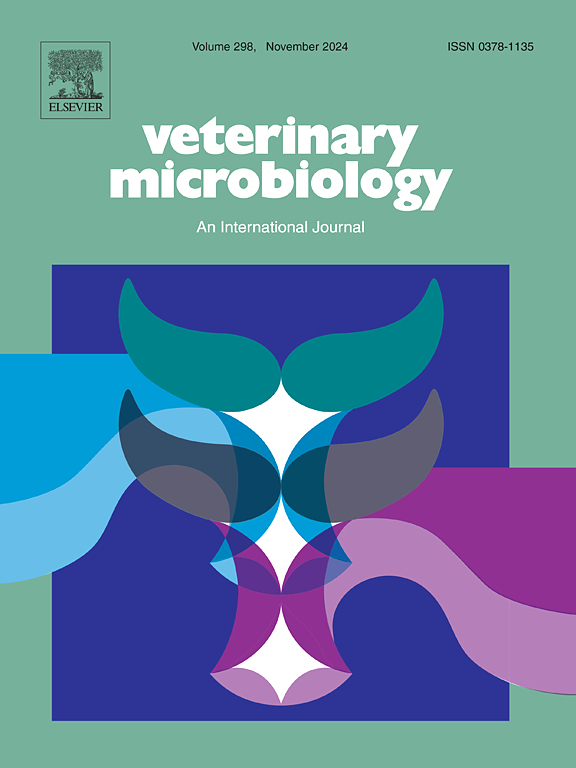Presence of infectious novel goose parvovirus in the skin of duck carcass associated with residual feather burrs
IF 2.7
2区 农林科学
Q3 MICROBIOLOGY
引用次数: 0
Abstract
Since the emergence of short beak and dwarfism syndrome (SBDS) among Cherry Valley ducks in China, duck carcasses associated with residual feather burrs have been frequently noticed. Novel goose parvovirus (NGPV) DNAs have been detected in the skins of these carcasses, however, whether NGPV present in these carcass skins is still viable remains unclear. In this study, skin samples were collected from duck carcasses with feather burrs at a local slaughterhouse. These samples were homogenized, and the sterilized homogenates were used to inoculate 9-day-old embryonated Cherry Valley duck eggs for viral isolation. Two NGPV isolates, designated as TX2302 and TX2309, were obtained and passaged in embryonated duck eggs. Their genomes were amplified by PCR, and the complete genome sequences were determined. In the phylogenetic tree constructed based on the coding protein sequences, TX2302 and TX2309 showed a closer genetic relationship with the NGPV strains isolated between 2019 and 2023. Experimental infection of 8-day-old Cherry Valley ducks with TX2302 reproduced clinical feathering disorders. Moreover, NGPV was detected in skins of the infected ducks until they reached 29 days of age. Overall, these results confirm the presence of infectious NGPV in the skin of duck carcass with feather burrs. Moreover, they demonstrate that NGPV infection alone can cause feathering disorders, potentially contributing to the formation of feather burrs in duck carcass.
鸭胴体皮肤中存在传染性新型鹅细小病毒并伴有羽刺残留
自从中国樱桃谷鸭出现短喙和侏儒症(SBDS)以来,鸭的尸体与残留的羽毛毛刺有关的问题经常被注意到。在这些胴体的皮肤中检测到新型鹅细小病毒(NGPV) dna,然而,这些胴体皮肤中是否存在NGPV仍不清楚。在这项研究中,皮肤样本是从当地屠宰场的鸭尸体上收集的。将这些样品匀浆,无菌匀浆接种9日龄樱桃谷鸭蛋进行病毒分离。获得了两个NGPV分离株TX2302和TX2309,并在鸭蛋胚中传代。用PCR扩增其基因组,测定其全基因组序列。在基于编码蛋白序列构建的系统进化树中,TX2302和TX2309与2019 - 2023年分离的NGPV菌株亲缘关系较近。8日龄樱桃谷鸭TX2302的实验感染再现了临床羽化障碍。此外,在感染鸭的皮肤中检测到NGPV,直到29日龄。综上所述,这些结果证实了具有羽毛毛刺的鸭胴体皮肤中存在传染性NGPV。此外,他们还证明,NGPV感染本身就会导致羽毛发育障碍,可能导致鸭胴体羽毛毛刺的形成。
本文章由计算机程序翻译,如有差异,请以英文原文为准。
求助全文
约1分钟内获得全文
求助全文
来源期刊

Veterinary microbiology
农林科学-兽医学
CiteScore
5.90
自引率
6.10%
发文量
221
审稿时长
52 days
期刊介绍:
Veterinary Microbiology is concerned with microbial (bacterial, fungal, viral) diseases of domesticated vertebrate animals (livestock, companion animals, fur-bearing animals, game, poultry, fish) that supply food, other useful products or companionship. In addition, Microbial diseases of wild animals living in captivity, or as members of the feral fauna will also be considered if the infections are of interest because of their interrelation with humans (zoonoses) and/or domestic animals. Studies of antimicrobial resistance are also included, provided that the results represent a substantial advance in knowledge. Authors are strongly encouraged to read - prior to submission - the Editorials (''Scope or cope'' and ''Scope or cope II'') published previously in the journal. The Editors reserve the right to suggest submission to another journal for those papers which they feel would be more appropriate for consideration by that journal.
Original research papers of high quality and novelty on aspects of control, host response, molecular biology, pathogenesis, prevention, and treatment of microbial diseases of animals are published. Papers dealing primarily with immunology, epidemiology, molecular biology and antiviral or microbial agents will only be considered if they demonstrate a clear impact on a disease. Papers focusing solely on diagnostic techniques (such as another PCR protocol or ELISA) will not be published - focus should be on a microorganism and not on a particular technique. Papers only reporting microbial sequences, transcriptomics data, or proteomics data will not be considered unless the results represent a substantial advance in knowledge.
Drug trial papers will be considered if they have general application or significance. Papers on the identification of microorganisms will also be considered, but detailed taxonomic studies do not fall within the scope of the journal. Case reports will not be published, unless they have general application or contain novel aspects. Papers of geographically limited interest, which repeat what had been established elsewhere will not be considered. The readership of the journal is global.
 求助内容:
求助内容: 应助结果提醒方式:
应助结果提醒方式:


